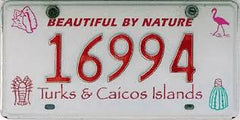Flamingo Facts!
We created our Frank the Flamingo Collection because, well, we just think they're cool? I mean what's better than flamingo jewelry? We reckon the real thing!
So we decided to do some internet digging and as it turns out they’re even more interesting than beautiful!
Where in Turks and Caicos Can You Find Flamingos?
- Just off of King’s Road between Whitby and Horsestable Beach, there is a lookout point over the Flamingo Pond on North Caicos.This area can be inhabited by the American Flamingo, and the flocks here are at times in the thousands, but not always. You need binoculars since you can’t get close to them.
- Flamingos are wading birds that live in areas of large shallow lakes, lagoons, mangrove swamps, tidal flats, and sandy islands which is why Turks and Caicos is perfect for them.
- There are 6 species of flamingos. The American flamingo (Phoenicopterus ruber) is a large species of flamingo closely related to the greater flamingo and Chilean flamingo. It is also known as the Caribbean flamingo, although it is present in the Galápagos Islands. It is the only flamingo that naturally inhabits North America.
How Long Do Flamingos Live?
- In the wild flamingos live 20 - 30 years and sometimes over 50 years in captivity.
Where Does the Name Flamingo Come From?
- The name "flamingo" comes from Portuguese or Spanish flamengo, "flame-colored", in turn coming from Provençal flamenc from flama "flame" and Germanic-like suffix "ing" with a possible influence of the Spanish ethnonym flamenco "Fleming" or "Flemish".
Why are Flamingos Pink?
- Flamingos may stamp their webbed feet in the mud to stir up food from the bottom.
- Adults range from light pink to bright red due to their food supply.
- A well-fed, healthy flamingo is more vibrantly colored, thus a more desirable mate; a white or pale flamingo is usually unhealthy or malnourished.
- Flamingos filter-feed on brine shrimp and blue-green algae as well as larva, small insects, mollusks and crustaceans making them omnivores. Their bills are specially adapted to separate mud and silt from the food they eat, and are uniquely used upside-down. The filtering of food items is assisted by hairy structures called lamellae, which line the mandibles, and the large, rough-surfaced tongue.
How Big is a Flamingo?
- The tallest of the 6 different species of flamingos, stands at 3.9 to 4.7 feet (1.2 to 1.4 m) with a weight up to 7.7 pounds (3.5 kg), and the shortest flamingo species (the lesser) has a height of 2.6 feet (0.8 m) and weighs just 5.5 pounds (2.5 kg).
-
Flamingos can have a wingspan as small as 37 inches (94 cm) to as big as 59 inches (150 cm).
- Flamingo legs can be longer than their entire body. The backward bending "knee" of a flamingo's leg is actually its ankle, the knee is out of sight further up the leg.
Why Do Flamingos Stand on One Leg?
- Some believe that flamingos stand on one foot because standing on one leg reduces the energy expenditure for producing muscular effort to stand and balance on one leg.
Can Flamingos Fly?
- When flamingos migrate, they do so mainly at night. They prefer to fly with a cloudless sky and favorable tailwinds. They can travel approximately 600 km (373 miles) in one night at about 50 to 60 kph (31-37 mph). When traveling during the day, the flamingos fly at high altitudes, possibly to avoid predation by eagles. (Seaworld.org)
What is a Group of Flamingos Called?
A group or flock of flamingos is called a flamboyance, isn't that cool?
Breeding of Flamingos
- Flamingos are very social birds; they live in colonies whose population can number in the thousands.
- Flamingo colonies split into breeding groups of up to 50 birds, who then perform a synchronized ritual 'dance' whereby they stand together stretching their necks upwards, uttering calls while waving their heads and then flapping their wings.
- Both the male and the female feed their chicks with a kind of crop milk, produced in glands lining the whole of the upper digestive tract.
- It only takes 7-12 days for a baby flamingo to start to explore surroundings outside of the nest.
The flamingo has a prominent place on previous Turks and Caicos license plates!

This information was taken from the Wikipedia, Visit TCI and from Science Kids!
Check out our flamingo jewelry!
